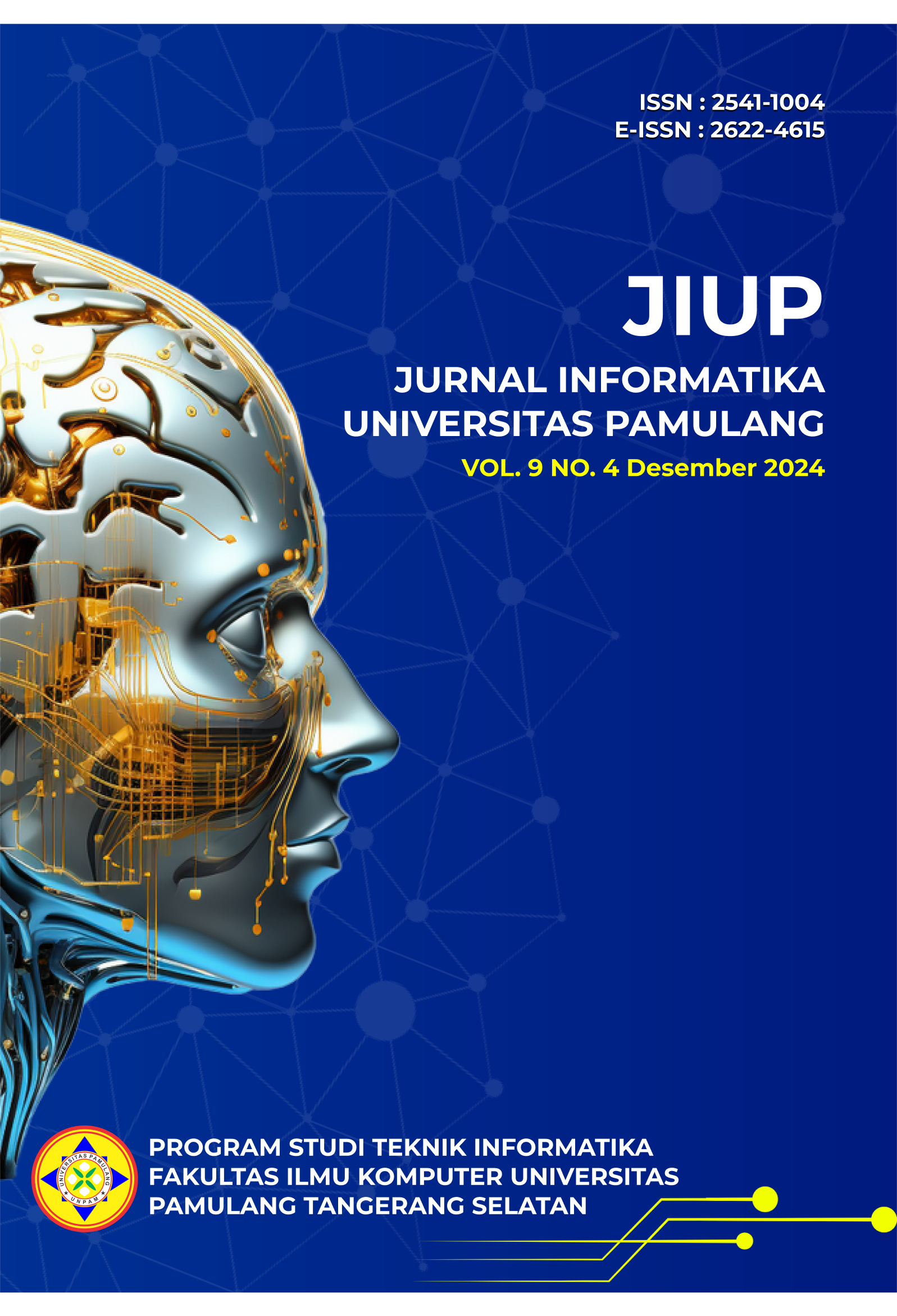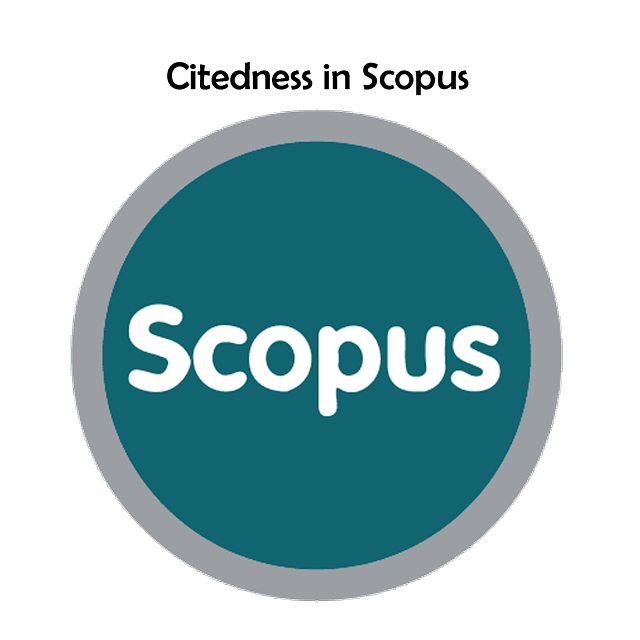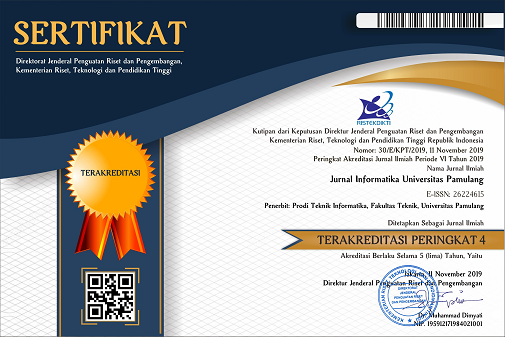Optimasi PSO untuk Meningkatkan Performa Algoritma C4.5 dalam Memprediksi Risiko Kesehatan Kehamilan
DOI:
https://doi.org/10.32493/informatika.v9i4.46039Keywords:
Analysis, Prediction, Algoritma C4.5, Particle Swarm Optimization, PregnancyAbstract
Nowadays, many diseases are feared to threaten the health of the body in pregnant women and their fetuses, so there is a need for early prevention. One's knowledge in predicting pregnancy health risks is important for prevention. However, precise prediction of such risks can be challenging, given the involvement of considerable and complex data. The C4.5 algorithm is widely used in data analysis. Unfortunately, its performance sometimes does not produce good accuracy. So, it needs to be improved by optimizing its structure parameters. For this reason, the purpose of this research involves the use of PSO (Particle Swarm Optimization) to find optimal parameters for the C4.5 algorithm that can increase the accuracy of pregnancy health risk prediction. The results show that the C4.5 algorithm model that has been optimized with PSO has an accuracy rate of 71.65%, and the standard C4.5 algorithm model only achieves an accuracy rate of 67.49%. There is a difference of 4.16%, which shows the superiority of the PSO optimization approach in improving prediction accuracy in the C4.5 algorithm. So, the application of the C4.5 algorithm optimized with PSO can be used as a positive implication in improving the health care of pregnant women and making more accurate medical decisions. Ultimately, this research illustrates the potential of PSO in optimizing the C4.5 data classification algorithm for health knowledge.
References
Anggita, S. D., & Ikmah, I. (2021). Implementasi Pso Untuk Optimasi Bobot Atribut Pada Algoritma C4.5 Dalam Prediksi Kelulusan Mahasiswa. JIPI (Jurnal Ilmiah Penelitian Dan Pembelajaran Informatika), 6(2), 416–423. https://doi.org/10.29100/jipi.v6i2.2440
Azuaje, F. (2006). Data Mining: Practical Machine Learning Tools and Techniques 2nd edition. BioMedical Engineering OnLine, 5(1). https://doi.org/10.1186/1475-925x-5-51
Fadilah, Z., & Murnawan. (2021). Performance Comparison of K-Nearest Neighbor and Decision Tree C4.5 by Utilizing Particle Swarm Optimization for Prediction of Liver Disease. International Journal of Open Information Technologies, 9(10), 9–15.
Fanani Rudi, M., & Fikriah Katul, F. (2023). Seleksi Fitur PSO untuk Klasifikasi Jenis Kekerasan dengan Algoritma C4.5. Smart Comp: Jurnalnya Orang Pintar Komputer, 12(1). https://doi.org/10.30591/smartcomp.v12i1.4407
Hayadi, B. H., & Damanik, A. R. (2022). Pendekatan Machine Learning Menggunakan Algoritma C4.5 Berbasis Pso Dalam Analisa Pemahaman Pemrograman Website. Jurnal Informatika Dan Teknik Elektro Terapan, 10(3).
Ilham, M., Adnyani, N. L. S. S., & Suryadi, K. (2024). Pembangunan Model Pendeteksi Risiko Preeklamsia pada Ibu Hamil dengan Menggunakan Metode Data Mining. Jurnal Teknik: Media Pengembangan Ilmu Dan Aplikasi Teknik, 23(1), 50–60. https://doi.org/10.55893/jt.vol23no1.543
Khalimi, A. M. (2022). Teknik Perhitungan Pada Atribut Data Numerik Algoritma C4.5. Pengalaman Edukasi. https://www.pengalaman-edukasi.com/2022/12/cara-menentukan-split-point-pada-data.html
Ma’mur, K. (2019). Analisis Penerapan Algoritma ID3 dalam Mendiagnosis Kesuburan Pria. Jurnal Informatika Universitas Pamulang, 4(2), 35. https://doi.org/10.32493/informatika.v4i2.2274
Nurlelah, E., & Mardiyanto, M. S. (2019). Pemilihan Atribut Pada Algoritma C4.5 Menggunakan Particle Swarm Optimization Untuk Meningkatkan Akurasi Prediksi Diagnosis Penyakit Liver. Jurnal Pilar Nusa Mandiri, 15(2), 195–202. https://doi.org/10.33480/pilar.v15i2.706
Putri, I. M., & Ismiyatun, N. (2020). Deteksi Dini Kehamilan Beresiko. JKM (Jurnal Kesehatan Masyarakat) Cendekia Utama, 8(1), 40. https://doi.org/10.31596/jkm.v8i1.565
Ratnaningtyas, M. A., & Indrawati, F. (2023). Karakteristik Ibu Hamil dengan Kejadian Kehamilan Risiko Tinggi. HIGEIA (Journal of Public Health Research and Development), 7(3), 334–344. https://doi.org/10.15294/higeia.v7i3.64147
Reza, A. A. R., & Muhammad Syaifur Rohman. (2024). Prediction Stunting Analysis Using Random Forest Algorithm and Random Search Optimization. Journal of Informatics and Telecommunication Engineering, 7(2), 534–544. https://doi.org/10.31289/jite.v7i2.10628
Rizki, A. M., & Nurlaili, A. L. (2021). Algoritme Particle Swarm Optimization (PSO) untuk Optimasi Perencanaan Produksi Agregat Multi-Site pada Industri Tekstil Rumahan. Journal of Computer, Electronic, and Telecommunication, 1(2), 1–9. https://doi.org/10.52435/complete.v1i2.73
Rizki Kurniawan, M., Nurul Sabrina, P., & Ilyas, R. (2024). Prediksi Customer Churn Pada Perusahaan Telekomunikasi Menggunakan Algoritma C4.5 Berbasis Particle Swarm Optimization. JATI (Jurnal Mahasiswa Teknik Informatika), 7(5), 3369–3375. https://doi.org/10.36040/jati.v7i5.7476
Rizqullah, M. F., Raihana, N. T., & Jambak, M. I. (2024). Komparasi Penerapan Algoritma C4.5, K-Nearest Neighbor, dan Naïve Bayes untuk Keberlangsungan Pasien Gagal Jantung. Klik: Kajian Ilmiah Informatika Dan Komputer, 4(5), 2580–2587. https://doi.org/10.30865/klik.v4i5.1788
Saputra, D., Irmayani, W., Purwaningtias, D., & Sidauruk, J. (2021). A Comparative Analysis of C4.5 Classification Algorithm, Naïve Bayes and Support Vector Machine Based on Particle Swarm Optimization (PSO) for Heart Disease Prediction. International Journal of Advances in Data and Information Systems, 2(2), 84–95. https://doi.org/10.25008/ijadis.v2i2.1221
Windasari, W. (2022). Optimalisasi Akurasi Data Mining Dengan Menggunakan Algoritma Pso. Journal of Data Science Theory and Application, 1(2), 66–71. https://doi.org/10.32639/jasta.v1i2.189
www.kuliahkomputer.com. (2018). Algoritma C4.5. Www.Kuliahkomputer.Com. https://www.kuliahkomputer.com/2018/07/algoritma-c45.html
Downloads
Published
Issue
Section
License
Copyright (c) 2024 Khaerul Ma'mur, Asep Erlan Maulana

This work is licensed under a Creative Commons Attribution-NonCommercial 4.0 International License.
Authors who publish with this journal agree to the following terms:
- Authors retain copyright and grant the journal right of first publication with the work simultaneously licensed under a Creative Commons Attribution-NonCommercial 4.0 International (CC BY-NC 4.0) that allows others to share the work with an acknowledgement of the work's authorship and initial publication in this journal.
- Authors are able to enter into separate, additional contractual arrangements for the non-exclusive distribution of the journal's published version of the work (e.g., post it to an institutional repository or publish it in a book), with an acknowledgement of its initial publication in this journal.
- Authors are permitted and encouraged to post their work online (e.g., in institutional repositories or on their website) prior to and during the submission process, as it can lead to productive exchanges, as well as earlier and greater citation of published work (See The Effect of Open Access).
Jurnal Informatika Universitas Pamulang have CC-BY-NC or an equivalent license as the optimal license for the publication, distribution, use, and reuse of scholarly work.
In developing strategy and setting priorities, Jurnal Informatika Universitas Pamulang recognize that free access is better than priced access, libre access is better than free access, and libre under CC-BY-NC or the equivalent is better than libre under more restrictive open licenses. We should achieve what we can when we can. We should not delay achieving free in order to achieve libre, and we should not stop with free when we can achieve libre.
Jurnal Informatika Universitas Pamulang is licensed under a Creative Commons Attribution-NonCommercial 4.0 International (CC BY-NC 4.0)
YOU ARE FREE TO:
- Share : copy and redistribute the material in any medium or format
- Adapt : remix, transform, and build upon the material for any purpose, even commercially.
- The licensor cannot revoke these freedoms as long as you follow the license terms





